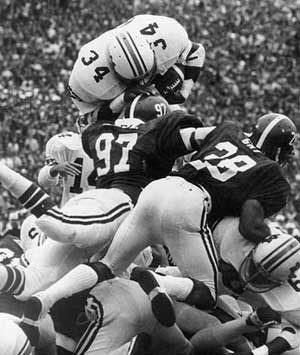College Football Meets Tradition, Tigers and Cougars

The Golden Dome, the winged helmet, the men of Troy, Script Ohio, Roll Tide and Boomer Sooner are but a handful of the College Football's earmarks of tradition and grandeur. Each moniker symbolizes the players, coaches, students, alumni, fans, and the stadiums of College Football's true powerhouses.
The debate of which college or university represents College Football's all-time greatest can be debated, but the answer truly cannot be agreed upon universally. With that in mind, the list of College Football's Powerhouse Programs will be defined based on recent history, i.e. 1980 to present day, with a school's all-time tradition being the tie-breaker in separating tier one schools from tier two schools. Heisman winners, winning consistently, consistently playing a good schedule, home game atmospheres, loyalty and size of a school's fan base, great coaches, recruiting prowess, national media attention, and staying within NCAA rules "and" the proverbial "where there's smoke there's fire" cliché, will all count towards a school's standing as either Tier I or Tier II as well.
The one common denominator to make Tier I for this list is that a school must have at least one national championship from 1980 until 2007. Otherwise, Tier II is automatically the best a team can do. Note: this list is subjective at best; a tweak in how the teams were placed into Tier I or Tier II would alter the rankings by a large margin. In short, this list is for fun.
In alphabetical order, starting the Tier II list is Auburn. The Tigers sported many big-time football players on offense and defense over the years, but have not made it over the hump to win a National Championship. Regardless of whom one roots for, the assembly line of Auburn tailbacks to the NFL has been incredible and should be given the utmost respect. Bo Jackson, in many people's opinion, is still the best tailback during the past thirty years, albeit a shortened career due to the hip injury he sustained that eventually ended his football playing days. James Brooks, "Cadillac" Williams, and Ronnie Brown are a few more of the talented Auburn tailbacks. Kevin Greene, the great pass rusher is also worthy of mention, as he went on to a fantastic NFL career after playing for Auburn.
Auburn has attracted many great recruits over the past twenty-eight College Football seasons, but it is not consistently mentioned amongst the nations top five or ten when recruiting rankings are released each February. They have won with above average talent, although not elite talent, very good coaching, and most notably, playing home games at Jordan-Haire Stadium, with chants of "War Eagle" and a deafening crowd-noise level that awaits visiting teams. Without question, making a trip Down on the Plains is a must for an avid College Football fan.
Biggest Positive: Bo Jackson. One of College Football's all-time great players, Jackson won the 1985 Heisman Trophy.
Biggest Negative: Auburn has been one of the most heavily penalized teams in NCAA history, being punished by the NCAA six times from 1957 to 1993 alone: NY Times.
While Auburn is known for its tailbacks, Brigham Young (BYU) is known for its aerial assault. Four BYU quarterbacks were awarded first team All-American status under now retired Cougars head coach LaVell Edwards: Gifford Nielson, Marc Wilson, Jim McMahon, and Steve Young. Additionally, quarterback Robbie Bosco led BYU to a 13-0 record and the 1984 National Championship. BYU consistently out-schemed, out-hustled, and definitely out-coached its opponents more often than not since Edwards took over in Provo, Utah, as the Cougars never make the elite list of top recruiting classes.
Edwards received a great deal of credit, and deservedly so, for the Cougars' success. Helping Edwards was offensive coordinator Norm Chow (now the offensive coordinator at UCLA). He directed the passing attacks that left many opponents guessing as to what had happened to their defenses after playing the Cougars. Chow's prowess as a quarterback guru is well known and if BYU would have produced even above average defenses during the time Edwards was paired with Chow, the Cougars would have likely had a few more undefeated regular seasons. Additionally, it should be noted that BYU is an extremely strict school and doesn't take many character risks that other programs do when it comes to recruiting. The cougars have seen a resurgence since head coach Bronco Mendenhall took over, and could make it to a BCS Bowl Game this after the conclusion of the 2008 regular season.
Biggest Positive: quarterback tradition, with an explosive offense directed by Edwards and Chow.
Biggest Negative: Poor competition. The Cougars do not play in a BCS Conference, and often faced a schedule that simply does not stack up to those in the major conferences such as the Big 10, SEC, or Pac 10.
The series continues with two more teams tomorrow.
Labels: Auburn, Bo Jackson, BYU, LaVell Edwards, Norm Chow

0 Comments:
Post a Comment
Subscribe to Post Comments [Atom]
<< Home